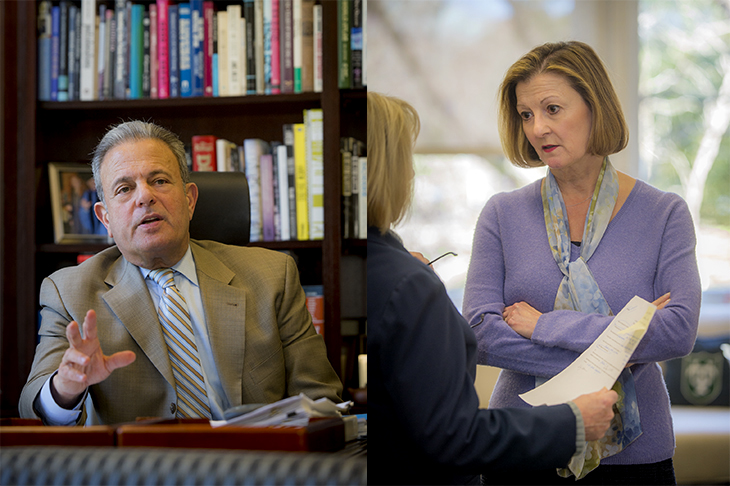Incentives may be key to budget model

Michael Bernstein, left, and Yvette Jones, right, are leading a committee tasked with creating a new budget model for Tulane University. (Photo by Paula Burch-Celentano)
Collaboration, transparency and incentives for trying new programs are key to a newly assembled group of Tulane University administrators, faculty and staff members as they work toward a new budget model for the coming years.
The Budget Redesign Steering Committee is working with representatives of the Huron Education consulting group as part of a universitywide effort to improve efficiency and increase revenue.
“Most importantly, we have to have a budget that is data-informed, very clear and understandable.”—Yvette Jones, executive vice president for university relations and development
The committee is co-chaired by Yvette Jones, executive vice president for university relations and development, and Michael Bernstein, provost and senior vice president for academic affairs.
“Most importantly, we are working toward developing a budget that is data-informed, very clear and understandable. There has to be transparency in it,” Jones said. “There have to be connections between performance and reward.”
The Budget Redesign Steering Committee is working in tandem with the Operational Review Steering Committee to solidify the university"s financial position and eliminate its annual cash deficit of $15 to $20 million.
Among the budget models being considered is an incentive-based structure that will encourage deans to try innovative programs, understanding that revenue generated from successful programs would go back into their school rather than flowing straight to the university"s bottom line.
“Units should have investment dollars for the future,” Jones said.
The committee will be considering a variety of models and choosing a system based on university goals, growth objectives and the unique culture at Tulane.
“It"s a good team,” Bernstein said. “We"re going to get some very interesting ideas.”
The 2016â“2017 fiscal year budget would be the first under the new model.
“We want to get this project done by the end of the semester,” Bernstein said, adding that the committee likely will plug the 2015â“2016 university budget into the new model “just to see what it looks like.”
About a third of Tulane"s budget comes from tuition and another third from grants, contracts and funded research activity, Bernstein said. The other two major sources of funding are revenue from the Tulane University Medical Group and fundraising and philanthropy.
